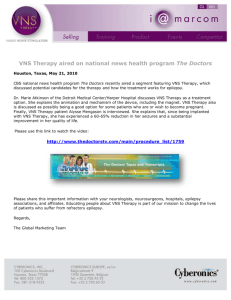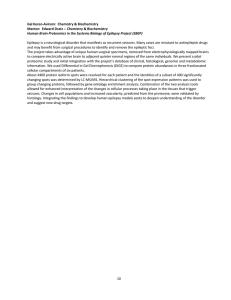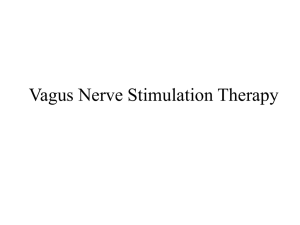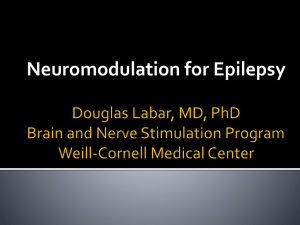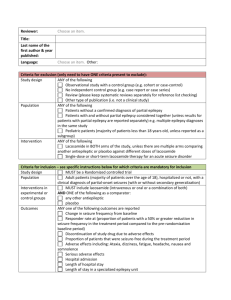vagus nerve Stimulation
advertisement
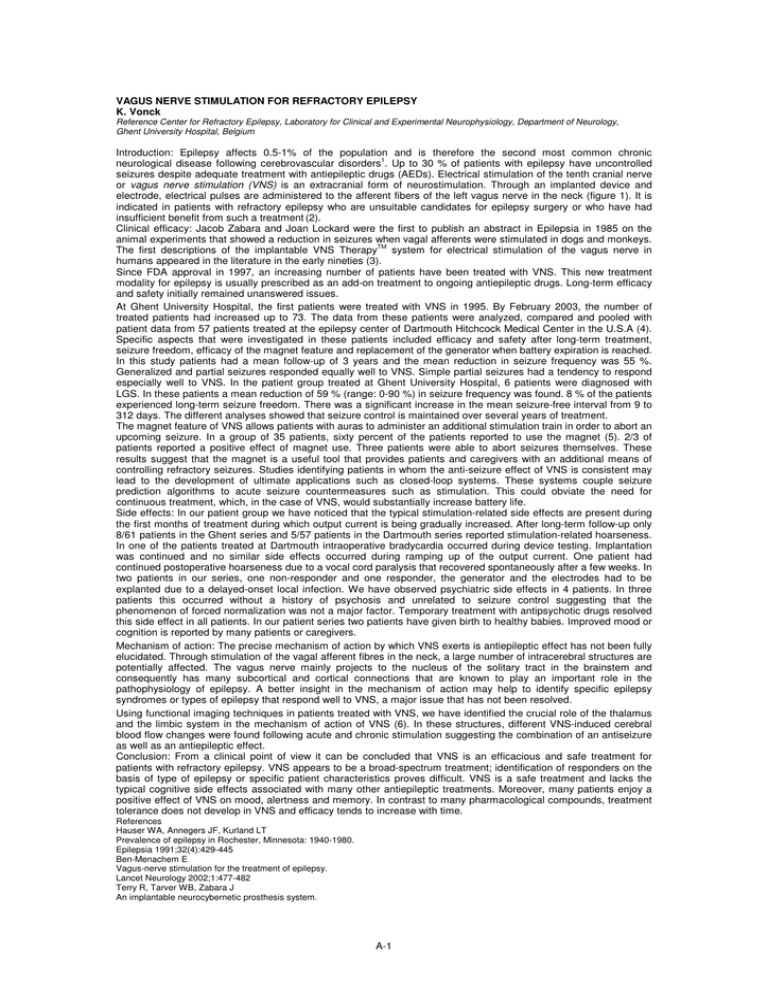
VAGUS NERVE STIMULATION FOR REFRACTORY EPILEPSY K. Vonck Reference Center for Refractory Epilepsy, Laboratory for Clinical and Experimental Neurophysiology, Department of Neurology, Ghent University Hospital, Belgium Introduction: Epilepsy affects 0.5-1% of the population and is therefore the second most common chronic neurological disease following cerebrovascular disorders1. Up to 30 % of patients with epilepsy have uncontrolled seizures despite adequate treatment with antiepileptic drugs (AEDs). Electrical stimulation of the tenth cranial nerve or vagus nerve stimulation (VNS) is an extracranial form of neurostimulation. Through an implanted device and electrode, electrical pulses are administered to the afferent fibers of the left vagus nerve in the neck (figure 1). It is indicated in patients with refractory epilepsy who are unsuitable candidates for epilepsy surgery or who have had insufficient benefit from such a treatment (2). Clinical efficacy: Jacob Zabara and Joan Lockard were the first to publish an abstract in Epilepsia in 1985 on the animal experiments that showed a reduction in seizures when vagal afferents were stimulated in dogs and monkeys. The first descriptions of the implantable VNS TherapyTM system for electrical stimulation of the vagus nerve in humans appeared in the literature in the early nineties (3). Since FDA approval in 1997, an increasing number of patients have been treated with VNS. This new treatment modality for epilepsy is usually prescribed as an add-on treatment to ongoing antiepileptic drugs. Long-term efficacy and safety initially remained unanswered issues. At Ghent University Hospital, the first patients were treated with VNS in 1995. By February 2003, the number of treated patients had increased up to 73. The data from these patients were analyzed, compared and pooled with patient data from 57 patients treated at the epilepsy center of Dartmouth Hitchcock Medical Center in the U.S.A (4). Specific aspects that were investigated in these patients included efficacy and safety after long-term treatment, seizure freedom, efficacy of the magnet feature and replacement of the generator when battery expiration is reached. In this study patients had a mean follow-up of 3 years and the mean reduction in seizure frequency was 55 %. Generalized and partial seizures responded equally well to VNS. Simple partial seizures had a tendency to respond especially well to VNS. In the patient group treated at Ghent University Hospital, 6 patients were diagnosed with LGS. In these patients a mean reduction of 59 % (range: 0-90 %) in seizure frequency was found. 8 % of the patients experienced long-term seizure freedom. There was a significant increase in the mean seizure-free interval from 9 to 312 days. The different analyses showed that seizure control is maintained over several years of treatment. The magnet feature of VNS allows patients with auras to administer an additional stimulation train in order to abort an upcoming seizure. In a group of 35 patients, sixty percent of the patients reported to use the magnet (5). 2/3 of patients reported a positive effect of magnet use. Three patients were able to abort seizures themselves. These results suggest that the magnet is a useful tool that provides patients and caregivers with an additional means of controlling refractory seizures. Studies identifying patients in whom the anti-seizure effect of VNS is consistent may lead to the development of ultimate applications such as closed-loop systems. These systems couple seizure prediction algorithms to acute seizure countermeasures such as stimulation. This could obviate the need for continuous treatment, which, in the case of VNS, would substantially increase battery life. Side effects: In our patient group we have noticed that the typical stimulation-related side effects are present during the first months of treatment during which output current is being gradually increased. After long-term follow-up only 8/61 patients in the Ghent series and 5/57 patients in the Dartmouth series reported stimulation-related hoarseness. In one of the patients treated at Dartmouth intraoperative bradycardia occurred during device testing. Implantation was continued and no similar side effects occurred during ramping up of the output current. One patient had continued postoperative hoarseness due to a vocal cord paralysis that recovered spontaneously after a few weeks. In two patients in our series, one non-responder and one responder, the generator and the electrodes had to be explanted due to a delayed-onset local infection. We have observed psychiatric side effects in 4 patients. In three patients this occurred without a history of psychosis and unrelated to seizure control suggesting that the phenomenon of forced normalization was not a major factor. Temporary treatment with antipsychotic drugs resolved this side effect in all patients. In our patient series two patients have given birth to healthy babies. Improved mood or cognition is reported by many patients or caregivers. Mechanism of action: The precise mechanism of action by which VNS exerts is antiepileptic effect has not been fully elucidated. Through stimulation of the vagal afferent fibres in the neck, a large number of intracerebral structures are potentially affected. The vagus nerve mainly projects to the nucleus of the solitary tract in the brainstem and consequently has many subcortical and cortical connections that are known to play an important role in the pathophysiology of epilepsy. A better insight in the mechanism of action may help to identify specific epilepsy syndromes or types of epilepsy that respond well to VNS, a major issue that has not been resolved. Using functional imaging techniques in patients treated with VNS, we have identified the crucial role of the thalamus and the limbic system in the mechanism of action of VNS (6). In these structures, different VNS-induced cerebral blood flow changes were found following acute and chronic stimulation suggesting the combination of an antiseizure as well as an antiepileptic effect. Conclusion: From a clinical point of view it can be concluded that VNS is an efficacious and safe treatment for patients with refractory epilepsy. VNS appears to be a broad-spectrum treatment; identification of responders on the basis of type of epilepsy or specific patient characteristics proves difficult. VNS is a safe treatment and lacks the typical cognitive side effects associated with many other antiepileptic treatments. Moreover, many patients enjoy a positive effect of VNS on mood, alertness and memory. In contrast to many pharmacological compounds, treatment tolerance does not develop in VNS and efficacy tends to increase with time. References Hauser WA, Annegers JF, Kurland LT Prevalence of epilepsy in Rochester, Minnesota: 1940-1980. Epilepsia 1991;32(4):429-445 Ben-Menachem E Vagus-nerve stimulation for the treatment of epilepsy. Lancet Neurology 2002;1:477-482 Terry R, Tarver WB, Zabara J An implantable neurocybernetic prosthesis system. A-1 Epilepsia 1990;31:S33-S37 Vonck K, Thadani V, Gilbert K, Dedeurwaerdere S, De Groote L, De Herdt V, Goossens L, Gossiaux F, Achten E, Thiery E, Vingerhoets G, Van Roost D, Caemaert J, De Reuck J, Roberts D, Williamson P, Boon P Vagus nerve stimulation, a transatlantic experience. Journal of Clinical Neurophysiology 2004 ;21(4):283-289 Boon P, Vonck K, Van Walleghem P, D’Have M, Goossens L, Vandekerckhove T, Caemaert J, De Reuck Programmed and magnet-induced vagus nerve stimulation for refractory epilepsy Journal of Clinical Neurophysiology 2001;18(5):402-7 Vonck K, Boon P, Van Laere K, D’Have M, Vandekerckhove T, O’Connor S, Brans B, Dierckx R, De Reuck J Acute single photon emission computed tomographic study of vagus nerve stimulation in refractory epilepsy. Epilepsia 2000;41:601-609 A-2
